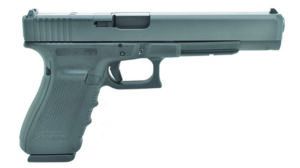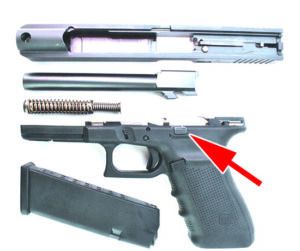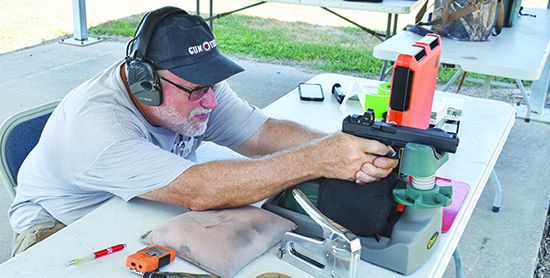It has become obvious that the shooting public recognizes the utility of the 10mm Automatic round as a self-protection cartridge. The 10mm Auto — we’ve actually heard it described as a “rimless 41 Magnum” — requires strong-framed guns, and manufacturers are responding. Gun builders keep designing new pistols for the cartridge, so we’ll keep reviewing them for you. With that in mind, we selected two 10mm Auto striker-fired pistols that come configured for the easy addition of optics.
Our first sample is the Glock G40 MOS. Sporting a 6-inch barrel and a muzzle-heavy design, the G40 MOS is designed to wring the most out of this cartridge while helping tame muzzle flip. It uses a 4th Generation large frame that can be sized up to fit the biggest bear-paw-sized hands.

Our second test piece is the new SIG Sauer P320 X10. Less than a quarter-inch longer than a full-sized 9mm P320, the X10 is also heavier and leaves the balance point well forward. Amazingly, the larger-caliber pistol fits in our existing P320 9mm gear.
In addition to bench testing, we also wanted to test practical accuracy, so we did two additional tests. The first used 3-by-5-inch stickies attached to paper targets 9 yards downrange. We recorded first-shot times as well as split times and totals using 180-grain ammo. The second was a single shot on an A Zone (5-by-11-inch) plate at 25 yards. Start position on both drills was from low ready. We tested using three different types of ammunition. The first was a 155-grain XTP from Hornady. Second was a 180-grain full-metal-jacket round from Armscor. Last was 200-grain Controlled Expansion ammo from Double Tap.
We wanted to test these two pistols for capabilities in self-defense as well as hunting situations and chose the Trijicon RMR with a 3.25-MOA dot as an optic. Well known for its durability, this sight is also light (1.2 ounces with the battery) and has an expected battery life of two years in typical use. Our LED sample was self-adjusting. Just point and shoot, so we did.
Glock G40 MOS PG4050200MOS10mm Auto
$729
GUN TESTS GRADE: A-
This Glock Model 40 MOS worked perfectly and shot well. That long nose helps it stay down on target for follow-up shots.

| Action Type | Semi-auto, striker fired |
| Overall Length | 9.5 in. |
| Overall Height | 5.1 in. |
| Maximum Width | 1.315 in. |
| Weight Unloaded | 2.0 lbs. |
| Weight Loaded | 2.8 lbs. |
| Slide Material | Stainless steel |
| Slide Retraction Effort | 16.9 lbs. |
| Receiver Material | Polymer |
| Finish | Tenifer |
| Front Strap Height | 2.5 in. |
| Back Strap Height | 3.5 in. |
| Barrel Length | 6.0 in. |
| Grip Thickness (Maximum) | 1.281 in. |
| Grip Circumference | 6.1 in. |
| Magazines | Three 15-round |
| Rear Sight | Glock white outline, drift adjustable |
| Front Sight | One-dot fixed |
| Sight Radius | 8.4 in. |
| Trigger Pull Weight | 5.5 lbs. |
| Trigger Span | 3.1 in. |
| Safety | Striker, trigger |
| Warranty | 1 year limited to original owner |
| Telephone | (770) 432-1202 |
| Website | US.Glock.com |
| Made In | Austria |
For someone who had never produced a handgun before, you have to admit Mr. Glock and his people have done extremely well. The Austrian military accepted his paradigm-breaking G17 in 1982, and Glock has never looked back. Constantly updated with innovation and new technology, “Glock Perfection” has now reached an official 5th Generation, and we would pose that the recently introduced Glock 47 is really Gen 6.
Our sample for this test is labeled as a Gen 4. By this point (2010), Glock had changed some internal parts from the original models, especially the springs, but the most noticeable difference was the grip. This version stayed with the finger grooves (which have since been removed, thankfully), but added the ability to customize the feel for larger hands. Now the shooter could add grip inserts, held by a single pin, that added girth and a bit more beavertail to the grip. They also settled on the “polymids,” which were pyramidal bumps on the grip panels that had been flattened. The grip adhesion from the finished product allowed a firm hold on the pistol without the texture being overly aggressive.
Our G40 (as are all the 45 ACP and 10mm pistols) is built on the large frame size. Some subsequent versions (45 ACP) have been offered on the Small Frame (SF), but, however you look at it, the larger chamberings require a larger frame than the 9mm version and those changes, minimal as they might be, are easily noticed. Our measurements, tested against the very recent Glock Model 47, shows the large frame to be about one-eighth inch wider, the grip approximately one-tenth inch wider, the grip to have a circumference about one-third inch wider, and a trigger span also one-eighth inch longer. These numbers are manageable for smaller to medium hands and wonderful for larger mitts.
This Model 40 is the quintessential large-size Glock pistol — almost. Those familiar with the Models 34 and 35 are used to the cutout in the slide, the object there being to leave the weight and balance approximately equal to the Model 17. The shooter gets a longer barrel and the velocity that goes with that, along with a longer sight radius for more precise aiming. Remember, all of these models were introduced before the advent (or at least the common usage) of optically-sighted pistols. The G40 gives you the longer barrel and sight radius while it leaves the slide whole, putting more weight out front to help the recoil of the 10mm version. While a full-sized 10mm is not what we would call a “thumper,” the difference in recoil between it and a similarly-sized pistol chambered in 45 ACP is noticeable.
Set side-by-side with a 9mm Glock, the differences are apparent. The slide is slightly thicker, and the resulting change in weight and balance is substantial.
Unlike the most modern versions, the G40 only has grasping grooves on the rear. The barrel is pushed out a full 6 inches, while the dust cover is that of a shorter pistol, a la the G34/35. The shorter dust cover allows for a standard-length recoil spring. The three-diameter nested spring in our sample looked a lot like the very modern G47 we have in house for a future test.

The slide on our G40 is cut for the MOS (Modular Optic System) plates. We ordered the full array (four adapter plates) that allows the pistol to accommodate a spectrum of red-dot sights. While the plate made for the Trijicon RMR attached to our pistol very easily, getting the dot attached was more problematic. Glock provided adapter plates that worked with four primary patterns: (1) Docter, Meopta, and Insight; (2) Trijicon; (3) C-More, and (4) Leupold. Then those four plates required three different kinds of screws to mount the red dots to the plates. Depending on the model, we could have needed M3, 6-32, or M4 screws to do the job. And try finding screws that will fit out of the package. Our RMR needed the 6-32 variety, but then we needed to get the grinder out to cut them down to length. We had about $200 of mounting screws in house and still had to fit our own.
Our RMR stayed solidly attached and did yeoman’s duty in the shooting tests. Note that the mounting plate is separate from the factory rear sight, and removal of the latter is not required in order to attach an optic. That said, the height of the rear deck on the RMR was above the top of the rear sight and did not allow the front sight to co-witness through the glass.
The G40’s frame is what you would expect from one of the company’s more-recent series. There is still more grip angle than with a 1911-style pistol. Nothing has changed. If you like the angle on your other Glocks, you’ll love this one. The magazine release is the larger style and is reversible. The slide release is left side only. The magazine well is lightly beveled, and the frame is cut up behind the trigger guard. The trigger guard, love it, hate it or indifferent to it, is still squared off for use by the support-hand index finger.
We tested with three different bullets, which included a very wide-mouthed jacketed hollow point (JHP). Because the 10mm has to fit in the same length magazine as a 45 ACP and the 10mm has a longer case than the 45, 10mm cartridges normally use short, rounded bullet shapes. Chamber and feed-ramp geometry must be spot on, and the Glock was 100% for function. The long, heavy muzzle made for a recoil impulse very different from the SIG X10. The G40 muzzle flip was lower and slower than the X10’s, feeling more like a 45 ACP impulse. That long nose of the G40 settled on target more quickly and shot the faster scores on our 5-by-11-inch plate at 25 yards — by about 0.07 seconds — with an average time to hit of 1.201 seconds. The G40 showed a preference for the Hornady and Doubletap ammo, averaging 1.63-inch groups for each at 30 yards. The Armscor 180-grain JHP, which did extremely well in our last 10mm test, was the poor performer this time, averaging groups just over 3.7 inches.
Our Team Said: The Glock functioned perfectly and shot well. Its long nose helps it stay on target for follow-up shots.
| RANGE DATA | ||
| Hornady Custom 155-grain XTP JHP | SIG Sauer P320 X10 | Glock Model 40 |
| Average Velocity | 1409 fps | 1454 fps |
| Muzzle Energy | 683 ft.-lbs. | 727 ft.-lbs. |
| Average Group | 2.50 in. | 1.63 in. |
| Best Group | 1.59 in. | 1.45 in. |
| Armscor USA 180-grain FMJ | SIG Sauer P320 X10 | Glock Model 40 |
| Average Velocity | 1110 fps | 1133 fps |
| Muzzle Energy | 492 ft.-lbs. | 513 ft.-lbs. |
| Average Group | 4.66 in. | 3.71 in. |
| Best Group | 4.06 in. | 3.01 in. |
| Doubletap 200-grain JHP | SIG Sauer P320 X10 | Glock Model 40 |
| Average Velocity | 1081 fps | 1124 fps |
| Muzzle Energy | 520 ft.-lbs. | 561 ft.-lbs. |
| Average Group | 2.36 in. | 1.63 in. |
| Best Group | 2.20 in. | 0.98 in. |
We tested at American Shooting Centers (AmericanShootingCenters.com) in Houston. We used a LabRadar chronograph (MyLabRadar.com, $559) to determine muzzle velocities. We fired bench-accuracy groups from a well-sandbagged Caldwell Pistol Rest from MidwayUSA (MidwayUSA.com), aided by a mini-DRC Fortune Cookie bag from Wiebad.com. Averages reflect five-shot groups at 30 yards.
| DRILL NO. 1 DATA | |
| Pistol | Single Shot Average |
| SIG P320 X10 | 1.268 |
| Glock 40 | 1.201 |
Process: Fire one shot from low ready at A Zone target (5-by-11 inches) placed at 25 yards. Numbers are averages for eight repetitions. Times are in seconds.
| DRILL NO. 2 DATA | |||
| Pistol | 1st Shot | Split Average | Total Time |
| SIG P320 X10 | 1.245 | 0.486 | 2.218 |
| Glock 40 | 1.265 | 0.58 | 2.425 |
Process: Fire three shots from low ready at a 3-by-5-inch target at 9 yards. Numbers are averages for four repetitions. Times are in seconds.
Written by Joe Woolley, using evaluations from Gun Tests Team members. Photographs by Joe Woolley and Roger Eckstine. GT




























I wish you would compare it to the model 20
Look forward to testing the Glock29SF an excellent backpacker companion and urban carry unit. Ruger 1911 in 10mm and Ed Brown long-slide would also be worthwhile to see reviewed.
It’s extremely evident Mr Woolly is Glock Fanboy. You got so excited about the Glock that you forgot to mention anything about the Sig. Not Gun Tests finest hour.
Glock 40 – installed a KKM Precision 6½, threaded barrel and aftermarket trigger. Smooth shooter. Accurate and easy follow-up shots. G40 has a large frame and grip to fill the hand for a full fit and good finger placement on trigger. The recoil, while significant, is more of a push rather than a sharp smack. May test with the KKM barrel with compensator. This pistol is large with few holster options. So far, chest carry seems the best option especially in the back country so hands can be kept free. See kkmprecision.com for the barrel which is a drop-in. No mods.